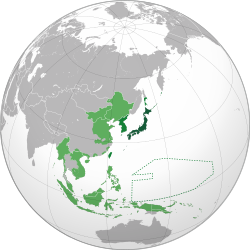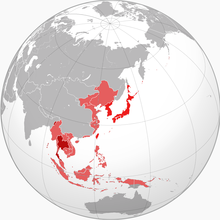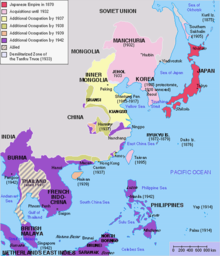
Back الإمبراطورية الاستعمارية اليابانية Arabic Imperio colonial japonés Spanish امپراتوری استعماری ژاپن Persian Empire colonial japonais French Imperium kolonial Jepang ID 日本帝国主義 Japanese Império colonial japonês Portuguese จักรวรรดิอาณานิคมญี่ปุ่น Thai Đế quốc thực dân Nhật Bản Vietnamese 日本殖民地 Chinese
Japanese Colonial Empire 日本植民地帝國 | |
|---|---|
| 1895–1945 | |
| Anthem: 君が代 ("Kimigayo") "His Imperial Majesty's Reign" | |
 The Japanese Empire in 1942
| |
| Status | Colonial empire |
| Capital | Tokyo City (1895–1943) Tokyo (1943–) |
| Common languages | Japanese Local: |
| History | |
• Established | 1895 |
• Disestablished | 1945[1] |
| Currency | Japanese yen, Japanese military yen, Korean yen, Taiwanese yen |

The territorial conquests of the Japanese Empire in the Western Pacific Ocean and East Asia began in 1895 with its victory over Qing China in the First Sino-Japanese War.[1] Subsequent victories over the Russian Empire (Russo-Japanese War) and the German Empire (World War I) expanded Japanese rule to Taiwan, Korea, Micronesia, Southern Sakhalin, several concessions in China, and the South Manchuria Railway. In 1931, Japan invaded Manchuria, resulting in the establishment of the puppet state of Manchukuo the following year; thereafter, Japan adopted a policy of founding and supporting puppet states in conquered regions. These conquered territories became the basis for the Greater East Asia Co-Prosperity Sphere in 1940.
Including Mainland Japan, colonies, occupied territories, and puppet states, the Japanese Empire at its apex was one of the largest empires in history. The total amount of land under Japanese sovereignty reached 8,510,000 km2 (3,300,000 sq mi) in 1942.[2] By 1943, it accounted for more than 20% of the world's population at the time with 463 million people in its occupied regions and territories.[3][4]
After Japan was defeated by the Allies in 1945, colonial control from Tokyo over the far-flung territories ended. The extent of Japanese governance was restricted to the naichi (excepting Karafuto Prefecture, which was annexed by the Soviet Union); the Nanpō and Ryūkyū Islands were returned to Japan by the US in 1968 and 1972 respectively.
The territorial expansion of the Japanese colonial empire was marked by aggression towards other nations, with the Japanese committing numerous atrocities and war crimes, killing millions.[5]

- ^ a b Peattie 1988, p. 217.
- ^ James, David H. (2010-11-01). The Rise and Fall of the Japanese Empire. Routledge. ISBN 978-1-136-92546-7. Archived from the original on 6 July 2019. Retrieved 11 September 2018.
by 1942, this 'Empire' covered about 3,285,000 square miles
- ^ http://www.populstat.info/Asia/asia.html Archived 2020-02-23 at the Wayback Machine Populstat ASIA
- ^ http://www.populstat.info/Oceania/oceania.html Archived 2020-02-25 at the Wayback Machine Populstat OCEANIA
- ^ Rigg, Bryan Mark (2024). Japan's Holocaust: History of Imperial Japan's Mass Murder and Rape During World War II. Knox Press. pp. 190–191, 276, 312. ISBN 9781637586884.
